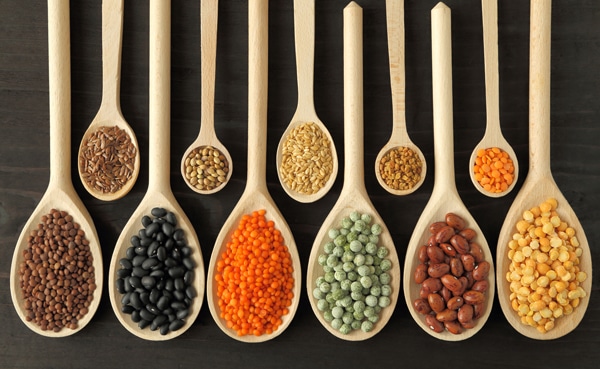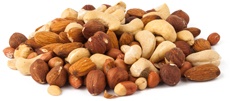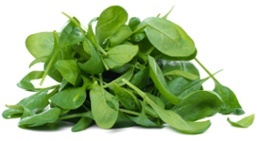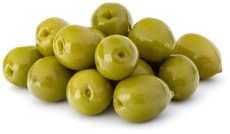Iron is an essential nutrient that plays an important role in many bodily functions.
A diet lacking in iron can result in low energy levels, shortness of breath, headaches, irritability, dizziness or anemia.
Iron can be found in two forms in foods — heme and non-heme. Heme iron is only found in animal products, whereas non-heme iron is only found in plants.
The recommended daily intake (RDI) is based on an average intake of 18 mg per day. However, individual requirements vary based on a person’s gender and life stage.
For instance, men and post-menopausal women generally require around 8 mg of iron per day. This amount increases to 18 mg per day for menstruating women and to 27 mg per day for pregnant women.
And, since non-heme iron tends to be less easily absorbed by our bodies than heme iron, the RDI for vegetarians and vegans is 1.8 times higher than for meat eaters.
Here is a list of 21 plant foods that are high in iron.
1–3: Legumes

Legumes, including beans, peas and lentils, are great sources of iron.
Listed below are the varieties containing the most iron, from highest to lowest.
1. Tofu, Tempeh, Natto and Soybeans
Soybeans and foods derived from soybeans are packed with iron.
In fact, soybeans contain around 8.8 mg of it per cup, or 49% of the RDI. The same portion of natto, a fermented soybean product, offers 15 mg, or 83% of the RDI.
Similarly, 6 ounces (168 grams) of tofu or tempeh each offer 3–3.6 mg of iron, or up to approximately 20% of the RDI.
In addition to iron, these soy products contain between 10–19 grams of protein per portion and are also a good source of calcium, phosphorus and magnesium.
2. Lentils
Lentils are another iron-filled food, providing 6.6 mg per cup cooked, or 37% of the RDI.
Lentils contain a significant amount of protein, complex carbs, fiber, folate and manganese as well. One cup of cooked lentils contains 18 grams of protein and covers around 50% of your recommended daily fiber intake.
3. Other Beans and Peas
Other types of beans contain good amounts of iron as well.
White, lima, red kidney and navy beans closely follow soybeans, offering 4.4–6.6 mg of iron per cup cooked, or 24–37% of the RDI.
However, chickpeas and black-eyed peas have the highest iron content. They provide around 4.6–5.2 mg per cup cooked, or 26–29% of the RDI.
In addition to their iron content, beans and peas are excellent sources of complex carbs, fiber, folate, phosphorus, potassium, manganese and several beneficial plant compounds.
Several studies also link regularly consuming beans and peas to lower blood pressure, cholesterol and blood sugar levels, as well as reductions in belly fat.
Summary: Beans, peas and lentils are rich in iron. These legumes also contain good amounts of protein, fiber, vitamins, minerals and beneficial plant compounds that may reduce your risk of various diseases.
4–5: Nuts and Seeds

Nuts and seeds serve as two more iron-rich plant sources.
Those who wish to increase their total daily iron intake should add the following varieties to their diet, as they contain the highest amounts.
4. Pumpkin, Sesame, Hemp and Flaxseeds
Pumpkin, sesame, hemp and flaxseeds are the seeds richest in iron, containing around 1.2–4.2 mg per two tablespoons, or 7–23% of the RDI.
Products derived from these seeds are also worth considering. For instance, two tablespoons of tahini, a paste made from sesame seeds, contain 2.6 mg of iron — which is 14% of the RDI.
Similarly, hummus made from chickpeas and tahini provides you with around 3 mg of iron per half cup, or 17% of the RDI.
Seeds contain good amounts of plant protein, fiber, calcium, magnesium, zinc, selenium, antioxidants and other beneficial plant compounds, too.
They’re also a great source of omega-3 and omega-6 fatty acids. Hemp seeds, in particular, seem to contain these two fats in the ratio considered optimal for human health.
5. Cashews, Pine Nuts and Other Nuts
Nuts and nut butters contain quite a bit of non-heme iron.
This is especially true for almonds, cashews, pine nuts and macadamia nuts, which contain between 1–1.6 mg of iron per ounce, or around 6–9% of the RDI.
Similarly to seeds, nuts are a great source of protein, fiber, good fats, vitamins and minerals, as well as antioxidants and beneficial plant compounds.
Keep in mind that blanching or roasting nuts may damage their nutrients, so favor raw and unblanched varieties.
As for nut butters, it’s best to choose a 100% natural variety to avoid an unnecessary dose of added oils, sugars and salt.
Summary: Nuts and seeds are good sources of non-heme iron, as well as an array of other vitamins, minerals, fiber, healthy fats and beneficial plant compounds. Add a small portion to your menu each day.
6–10: Vegetables

Gram per gram, vegetables often have a higher iron content than foods typically associated with high iron, such as meat and eggs.
Though vegetables contain non-heme iron, which is less easily absorbed, they are also generally rich in vitamin C, which helps enhance iron absorption.
The following vegetables and vegetable-derived products offer the most iron per serving.
6. Leafy Greens
Leafy greens, such as spinach, kale, swiss chard, collard and beet greens contain between 2.5–6.4 mg of iron per cooked cup, or 14–36% of the RDI.
For example, 100 grams of spinach contains 1.1 times more iron than the same amount of red meat and 2.2 times more than 100 grams of salmon.
This is also 3 times more than 100 grams of boiled eggs and 3.6 times more than the same amount of chicken.
Yet due to their light weight, some can find it difficult to consume 100 grams of raw, leafy greens. In this case, it’s best to consume them cooked.
Other iron-rich veggies that fit in this category include broccoli, cabbage and Brussels sprouts, which contain between 1 and 1.8 mg per cooked cup, or around 6–10% of the RDI.
7. Tomato Paste
At 0.5 mg per cup, raw tomatoes contain very little iron. However, when dried or concentrated, they offer a much greater amount.
For instance, half a cup (118 ml) of tomato paste offers 3.9 mg of iron, or 22% of the RDI, whereas 1 cup (237 ml) of tomato sauce offers 1.9 mg, or 11% of the RDI.
Sun-dried tomatoes are another iron-rich source, providing you with 1.3–2.5 mg per half cup, or up to 14% of the RDI.
Tomatoes are also a great source of vitamin C, which helps increase iron absorption. Moreover, they’re a great source of lycopene, an antioxidant linked to a reduced risk of sunburn.
8. Potatoes
Potatoes contain significant amounts of iron, mostly concentrated in their skins.
More specifically, one large, unpeeled potato (10.5 ounces or 295 grams) provides 3.2 mg of iron, which is 18% of the RDI. Sweet potatoes contain slightly less — around 2.1 mg for the same quantity, or 12% of the RDI.
Potatoes are also a great source of fiber. Additionally, one portion can cover up to 46% of your daily vitamin C, B6 and potassium requirements.
9. Mushrooms
Certain varieties of mushrooms are particularly rich in iron.
For instance, one cooked cup of white mushrooms contains around 2.7 mg, or 15% of the RDI.
Oyster mushrooms may offer up to twice as much iron, whereas portobello and shiitake mushrooms contain very little.
10. Palm Hearts
Palm hearts are a tropical vegetable rich in fiber, potassium, manganese, vitamin C and folate.
A lesser-known fact about palm hearts is that they also contain a fair amount of iron — an impressive 4.6 mg per cup, or 26% of the RDI.
This versatile vegetable can be blended into dips, tossed on the grill, incorporated into a stir-fry, added to salads and even baked with your favorite toppings.
Summary: Vegetables often contain significant amounts of iron. Their generally large volume-to-weight ratio explains why eating them cooked may make it easier to meet your daily requirements.
11–13 Fruit

Fruit is not commonly the food group that individuals turn to when wanting to increase the iron content of their diet.
Nevertheless, some fruits are surprisingly high in iron.
Here are the best sources of iron in this category.
11. Prune Juice
Prunes are known for their mild laxative effect, which helps relieve constipation.
However, they’re also a good source of iron.
Prune juice, in particular, offers about 3 mg of iron per cup (237 ml). That’s around 17% of the RDI and is twice as much iron than the same quantity of prunes.
Prune juice is rich in fiber, potassium, vitamin C, vitamin B6 and manganese, too.
12. Olives
Olives are technically a fruit, and one with a good iron content at that.
They contain around 3.3 mg of iron per 3.5 ounces (100 grams), or 18% of the RDI. In addition, fresh olives are also a great source of fiber, good fats and fat-soluble vitamins A and E.
Olives also contain a variety of beneficial plant compounds thought to provide several health benefits, including a lower risk of heart disease.
13. Mulberries
Mulberries are a type of fruit with a particularly impressive nutritional value.
Not only do they offer around 2.6 mg of iron per cup — 14% of the RDI — but this quantity of mulberries also meets 85% of the RDI for vitamin C.
Mulberries are a great source of antioxidants as well, which may offer protection against heart disease, diabetes and some forms of cancer.
Summary: Prune juice, olives and mulberries are the three types of fruit with the highest iron concentration per portion. These fruit also contain antioxidants and a variety of other nutrients beneficial to health.
14–17: Whole Grains

Research links whole grains to a variety of health benefits.
These benefits include increased longevity and a reduced risk of obesity, type 2 diabetes and heart disease.
However, not all grains are equally beneficial. For instance, grain processing typically removes parts of the grain that contain fiber, antioxidants, vitamins and minerals, including iron.
For this reason, whole grains typically contain more iron than processed grains. The following are the four types of whole grains containing the most iron per portion.
14. Amaranth
Amaranth is a gluten-free ancient grain that doesn’t grow from grasses like other grains do. For this reason, it is technically considered a “pseudocereal.”
Amaranth contains around 5.2 mg of iron per cup cooked, or 29% of the RDI.
Interestingly, amaranth is one of the few complete sources of plant proteins and also contains good amounts of complex carbs, fiber, manganese, phosphorus and magnesium.
15. Spelt
Spelt is another iron-rich ancient grain.
It contains around 3.2 mg of iron per cup cooked, or 18% of the RDI. Moreover, spelt offers around 5–6 grams of protein per portion, which is approximately 1.5 times more protein than more modern grains, such as wheat.
Spelt contains a variety of other nutrients, too, including complex carbs, fiber, magnesium, zinc, selenium and B vitamins. Its mineral content may also be slightly higher than more conventional grains.
16. Oats
Oats are a tasty and easy way to add iron to your diet.
A cup of cooked oats contains around 3.4 mg of iron — 19% of the RDI — as well as good amounts of plant protein, fiber, magnesium, zinc and folate.
What’s more, oats contain a soluble fiber called beta-glucan, which may help promote gut health, increase feelings of fullness and reduce cholesterol and blood sugar levels.
17. Quinoa
Like amaranth, quinoa is a gluten-free pseudocereal rich in complete protein, fiber, complex carbs, vitamins and minerals.
It offers around 2.8 mg of iron per cup cooked, or 16% of the RDI. Plus, research links quinoa’s rich antioxidant content to a lower risk of medical conditions, including high blood pressure and type 2 diabetes.
Summary: Whole grains generally contain more iron than refined grains. The varieties listed above are particularly rich in iron but also contain several other nutrients and plant compounds beneficial to health.
18–21: Other

Certain foods do not fit in one of the food groups above, yet contain significant amounts of iron.
Incorporating them into your diet can help you meet your recommended daily iron intakes.
18. Coconut Milk
Coconut milk can be a tasty alternative to cow’s milk.
Although very high in fat, it’s a good source of several vitamins and minerals, including magnesium, copper and manganese.
Coconut milk also contains a good amount of iron — more specifically, around 3.8 mg per half cup (118 ml), or around 21% of the RDI.
19. Dark Chocolate
Dark chocolate contains significantly more nutrients than its milk chocolate counterpart.
Not only does it offer 3.3 mg of iron per ounce (28 grams), meeting around 18% of the RDI, but it also contains a good amount of fiber, magnesium, copper and manganese.
Additionally, dark chocolate is a powerful source of antioxidants, a group of beneficial plant compounds that help protect against various diseases.
20. Blackstrap Molasses
Blackstrap molasses is a sweetener often claimed to be healthier than table sugar.
In terms of iron, it contains around 1.8 mg of iron per two tablespoons, or around 10% of the RDI.
This portion also helps cover between 10–30% of your recommended daily intake of copper, selenium, potassium, vitamin B6, magnesium and manganese.
However, despite its higher nutrient content, blackstrap molasses remains very high in sugar and should be consumed in moderation.
21. Dried Thyme
Dried thyme is one of the most popular culinary herbs.
Many consider it a nutritional powerhouse, and research has linked it to health benefits ranging from fighting bacterial infections and bronchitis to improving your mood.
Thyme also happens to be one of the herbs with the highest iron content, offering 1.2 mg per dried teaspoon, or around 7% of the RDI (76).
Sprinkling a little on each meal is a good strategy for those wanting to increase their iron intake.
Summary: Coconut milk, dark chocolate, blackstrap molasses and dried thyme are lesser known, yet undoubtedly rich, sources of iron.
How to Increase Iron Absorption From Plant Foods
The heme iron found in meat and animal products is generally more easily absorbed by the human body than the non-heme iron found in plants.
For this reason, the recommended daily intake of iron is 1.8 times higher for vegetarians and vegans than those who eat meat.
This amounts to approximately 14 mg per day for men and post-menopausal women, 32 mg per day for menstruating women and 49 mg per day for pregnant women (1).
However, there are various strategies that can be employed to increase the body’s ability to absorb non-heme iron. Here are the best-researched methods:
- Eat vitamin C-rich foods: Consuming vitamin C-rich foods together with foods rich in non-heme iron may increase the absorption of iron by up 300%.
- Avoid coffee and tea with meals: Drinking coffee and tea with meals can reduce iron absorption by 50-90% (77).
- Soak, sprout and ferment: Soaking, sprouting and fermenting grains and legumes can improve iron absorption by lowering the amount of phytates naturally present in these foods.
- Use a cast iron pan: Foods prepared in a cast iron pan tend to provide two to three times more iron as those prepared in non-iron cookware.
- Consume lysine-rich foods: Consuming plant foods like legumes and quinoa that are rich in the amino acid lysine together with your iron-rich meals may increase iron absorption.
Summary: The type of iron found in plant foods (non-heme) is less easily absorbed by the body. The methods outlined here can be used to maximize its absorption.
The Bottom Line
Iron is a nutrient necessary for good functioning of the human body.
This mineral can be found in an array of different foods, including many plant foods.
Besides being a good source of iron, the plant foods listed in this article also happen to contain a variety of other nutrients and beneficial plant compounds.
Thus, incorporating them into your diet will not only help you meet your iron requirements, but will also likely benefit your overall health.
Source: AuthorityNutrition
